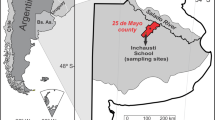Summary
Release of inorganic N and P in the organic soils of three small quaking fens in The Netherlands was studied by means of in situ incubation of the peat soil in plastic bottles. One of the fens had higher biomass production and lower species richness than the other two. The former fen is located in an area with downward groundwater percolation, whereas the latter fens are situated in an area of upward seepage of groundwater rich in calcium and bicarbonate.
Mineralization of N proved to be slow in the low-productive fens, and 6 times faster in the highly productive fen. In the latter fen the amount of N mineralized during a certain period exceeded by far the amount accumulated in that period in the above-ground parts of the vegetation.
The release of inorganic P was extremely slow in the two low-productive fens and rapid in the highly productive fen. The release rates were not related to the total P content of the soils. The slow P release in the low-productive fens may be due to the continuous inflow of groundwater rich in Ca, Al and Fe compounds.
It can be concluded that the soil is a potentially large source of inorganic N and P in quaking fens. The importance of the soil versus other N and P sources is greater in nutrient-rich fens.
Similar content being viewed by others
References
Beltman B (1984) The role of water balance studies in environmental planning. Proc 1st International Seminar of the International Association of Landscape Ecology, Roskilde, Denmark, vol IV, pp 131–137
Bietz JA (1974) Micro-Kjeldahl analysis by an improved automated ammonia determination following manual digestion. Anal Chem 46:1617–1618
Clymo RS (1965) Experiments on breakdown of Sphagnum in two bogs. J Ecol 53:747–758
Daughtrey ZW, Gilliam JW, Kamprath EJ (1973) Phosphorus supply characteristics of acid organic soils as measured by desorption and mineralization. Soil Sci 115:18–24
Downes MT (1978) An improved hydrazine reduction method for the automated determination of low nitrate levels in freshwater. Water Res 12:673–675
Hammer DE, Kadlec RH (1982) A strategy for analysis of wetlands wastewater treatment systems. Report RS Kerr Lab, Office of Research and Development, US EPA, Ada, Oklahoma, pp 28
Hemond HF (1983) The nitrogen budget of Thoreau's bog. Ecology 64:99–109
Holford ICR, Patrick WH (1979) Effects of redox potential and pH on phosphate removal from wastewater during land application. Prog Wat Tech 11:215–225
Lennox LJ (1979) An automated procedure for the determination of phosphorus. Water Res 13:1329–1333
MacGrimmon HR (1980) Nutrient and sediment retention in a temperate marsh ecosystem. Int Rev ges Hydrobiol 65:719–744
Patrick WH (1974) Phosphate release and sorption by soils and sediments: effects of aerobic and anaerobic conditions. Science 186:53–55
Peverly JH (1982) Stream transport of nutrients through a wetland. J Environ Qual 11:38–43
Richardson CJ, Marshall PE (1986) Processes controlling movement, storage, and export of phosphorus in a fen peatland. Ecol Monogr 56(4):279–302
Sahrawat KL (1982) Assay of nitrogen supplying capacity of tropical rice soils. Plant and Soil 65:111–121
Sikora LJ, Keeney DR (1983) Further aspects of soil chemistry under anaerobic conditions. In: Gore AJP (ed) Mires: swamp, bog, fen and moor. Ecosystems of the world, vol 4A. Elsevier, Amsterdam, pp 247–256
Sokal RR, Rohlf FJ (1981) Biometry. Freeman, San Francisco, pp 859
Van Diest A, Black CA (1958) Soil organic phosphorus and plant growth. II. Organic phosphorus mineralized during incubation. Soil Sci 87:145–154
Van Wirdum G (1979) Dynamic aspects of trophic gradients in a mire complex. In. Comm Hydrol Res TNO, Proc of Techn Meeting 35, Proc and Interm 25, The Hague, Netherlands, pp 66–82
Verhoeven JTA (1983) Nutrient dynamics in mesotrophic fens under the influence of eutrophicated ground water. Proc Int Symp Aquat Macrophytes, Nijmegen, The Netherlands, pp 241–250
Verhoeven JTA, Beek S van, Dekker M, Storm W (1983) Nutrient dynamics in small mesotrophic fens surrounded by cultivated land. I. Productivity and nutrient uptake by the vegetation in relation to the flow of eutrophicated ground water. Oecologia (Berlin) 60:25–33
Vermeer JG (1986) The effects of nutrient addition on shoot biomass and species composition of wetland and hayfield communities. Oecologia Plantarum 7:31–41
Waughman GJ (1980) Chemical aspects of the ecology of some South German peatlands. J Ecol 68:1025–1046
Author information
Authors and Affiliations
Rights and permissions
About this article
Cite this article
Verhoeven, J.T.A., Arts, H.H.M. Nutrient dynamics in small mesotrophic fens surrounded by cultivated land. Oecologia 72, 557–561 (1987). https://doi.org/10.1007/BF00378982
Received:
Issue Date:
DOI: https://doi.org/10.1007/BF00378982




